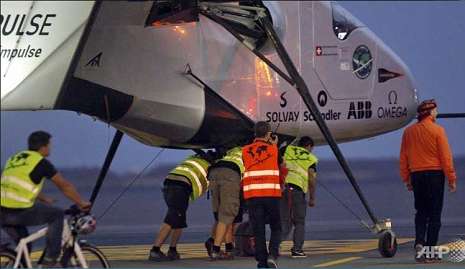The aircraft touched down in the western state of Gujarat at 11.25pm (1.55am Singapore time Wednesday) to finish its trip from the Omani capital Muscat in little less than 16 hours.
Live footage on its website showed the faint line of the plane`s white-and-blue lights in the pitch-black night as the Solar Impulse 2 approached Gujarat`s main city of Ahmedabad.
Members in the control room applauded as Pilot Bertrand Piccard, who was at the controls on the 1,465 kilometre journey over the Arabian Sea, landed at Sardar Vallabhbhai Patel International Airport.
"Congratulations to @bertrandpiccard from Mission Control... Landing 11.25pm local time," the Solar Impulse team posted on Twitter.
The Solar Impulse will be in Ahmedabad for four days during which "several events are planned on the theme of renewable energy and sustainable development", according to the Swiss embassy.
The aircraft will embark on its fourth leg to Myanmar on Mar 16 after making a short stop at the Hindu holy city of Varanasi in northern India.
The sea legs pose the greatest challenge for the Solar Impulse team as any loss of power over the water would leave the pilot no alternative but to bail out and await rescue by boat.
Much bigger crossings lie ahead as Piccard and fellow Swiss aviator Andre Borschberg, who alternate at the controls of the single-seat aircraft, traverse the great oceans.
The longest single leg will see one of them fly solo non-stop for five days and nights across the Pacific from Nanjing, China to Hawaii, a distance of 8,500 kilometres.
Muscat was the first of 12 planned stops on the plane`s journey around the world from Abu Dhabi, with a total flight time of around 25 days spread over five months.
Monday`s maiden leg took Borschberg 13 hours and two minutes. He spoke of an "emotional" trip, telling reporters he cruised at 6,000 metres because the trip was "short". Piccard was flying even higher as he entered Pakistani airspace on Tuesday, at 8,230 metres, his support team said.
`FLYING INTO SUSTAINABLE FUTURE`
The team hope to promote green energy with the circumnavigation attempt, which was ridiculed by the aviation industry when it was first unveiled.
UN chief Ban Ki-moon hailed the venture and congratulated the pilots. "With their daring and determination, we can all fly into a new sustainable future," his spokesman said.
The pilots` native Switzerland issued a special commemorative coin to mark the launch, which is the culmination of 13 years of research and testing.
The Si2 is the first solar-powered aircraft able to stay aloft for several days and nights. It is powered by more than 17,000 solar cells built into wings that, at 72 metres, are longer than those of a Boeing 747 and approaching those of an Airbus A380 superjumbo.
Thanks to an innovative design, the lightweight carbon fibre aircraft weighs only 2.3 tonnes, about the same as a family 4X4 and less than one percent of the weight of the A380. The propeller-driven craft has four 17.5-horsepower electric motors with rechargeable lithium batteries.
It will travel at 50-100 kilometres per hour, the slower speeds at night to prevent the batteries from draining too quickly. The plane can fly on autopilot during rest breaks but both pilots have undergone intensive training to prepare them for the long solo flights.
They have learnt techniques, including yoga and self-hypnosis, to allow them to sleep for periods as short as 20 minutes but still wake up feeling refreshed.
While in the air, the pilots are linked to a control centre in Monaco where 65 weathermen, air traffic controllers and engineers are stationed. A team of 65 ground staff is travelling around the world with the two pilots.
After Myanmar the plane will head to China, Hawaii and New York. From there it will go on towards its starting point in Abu Dhabi via either southern Europe or North Africa, depending on weather conditions.
More about:














































